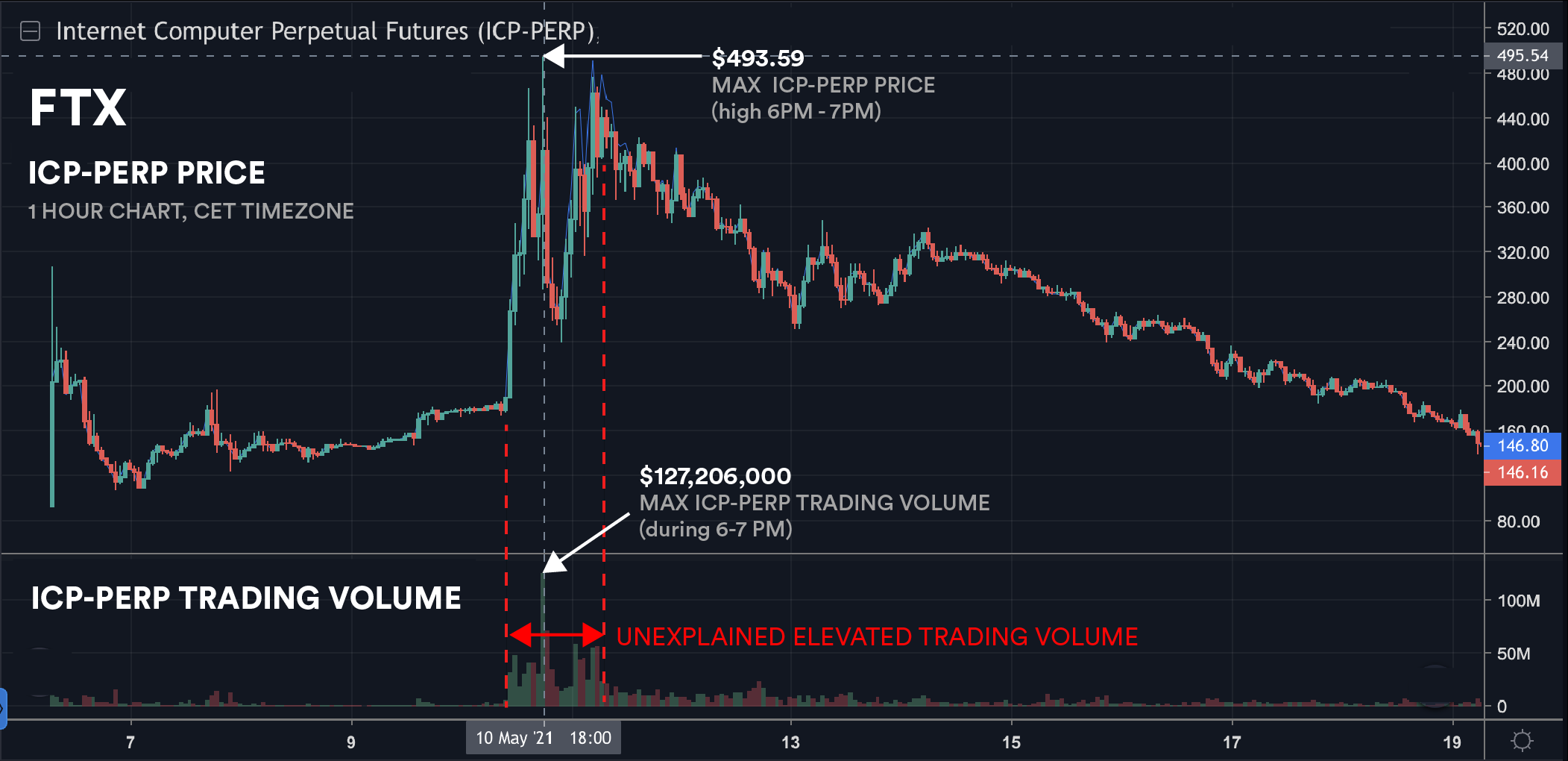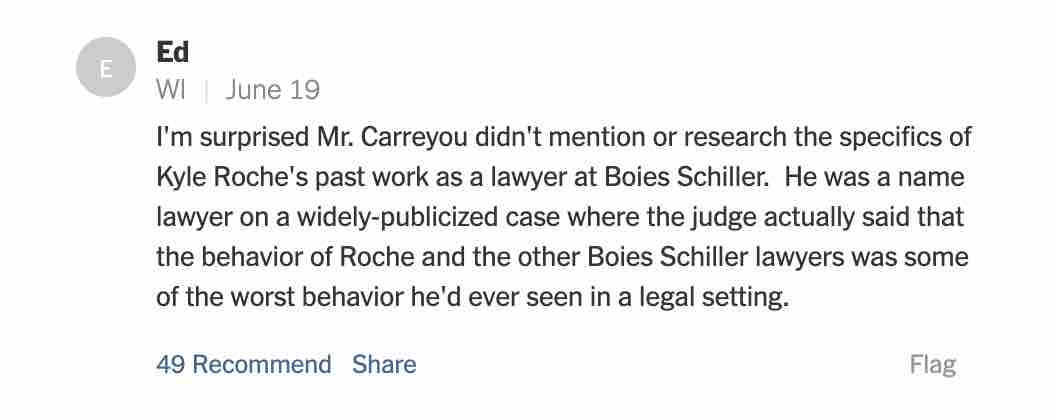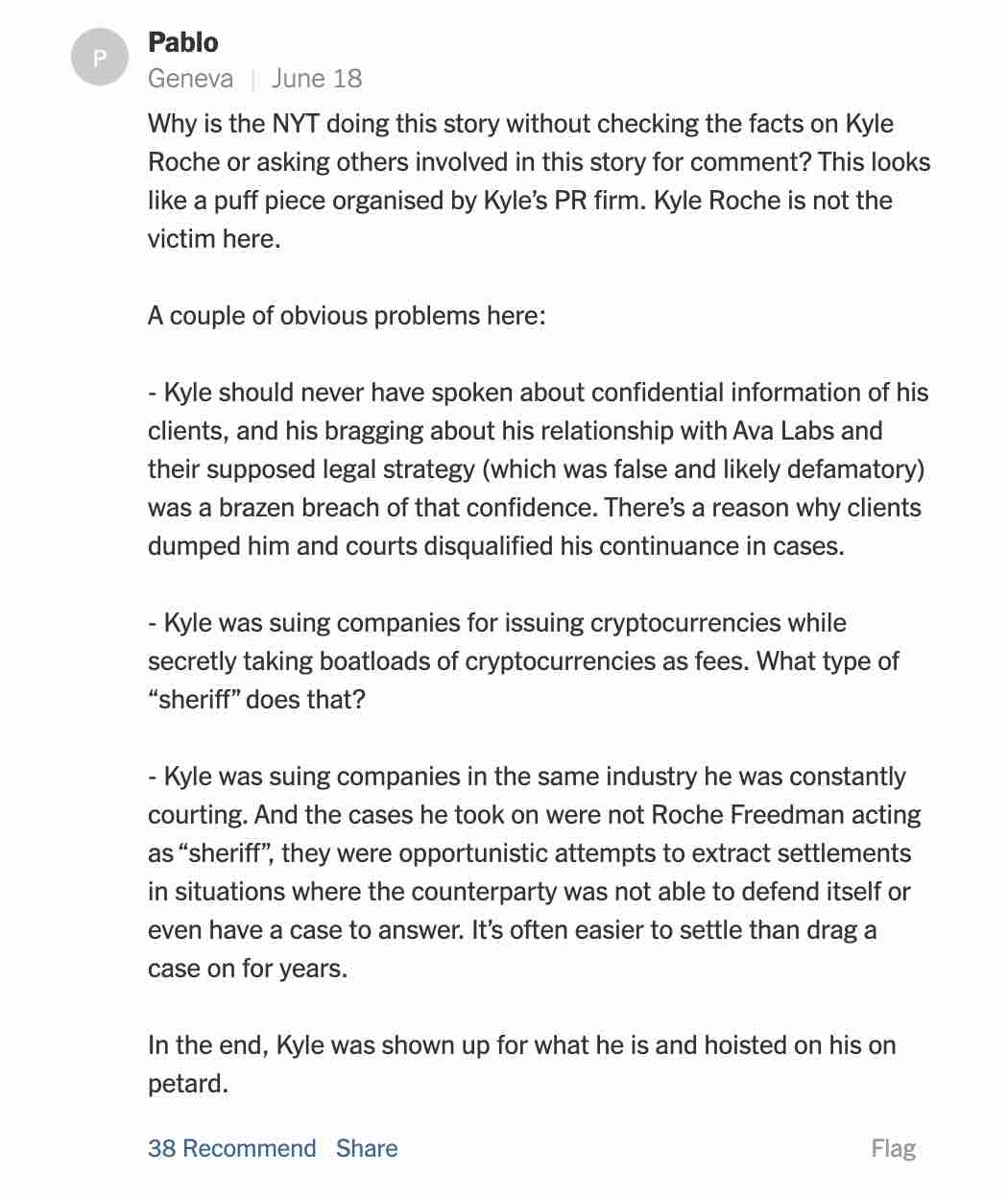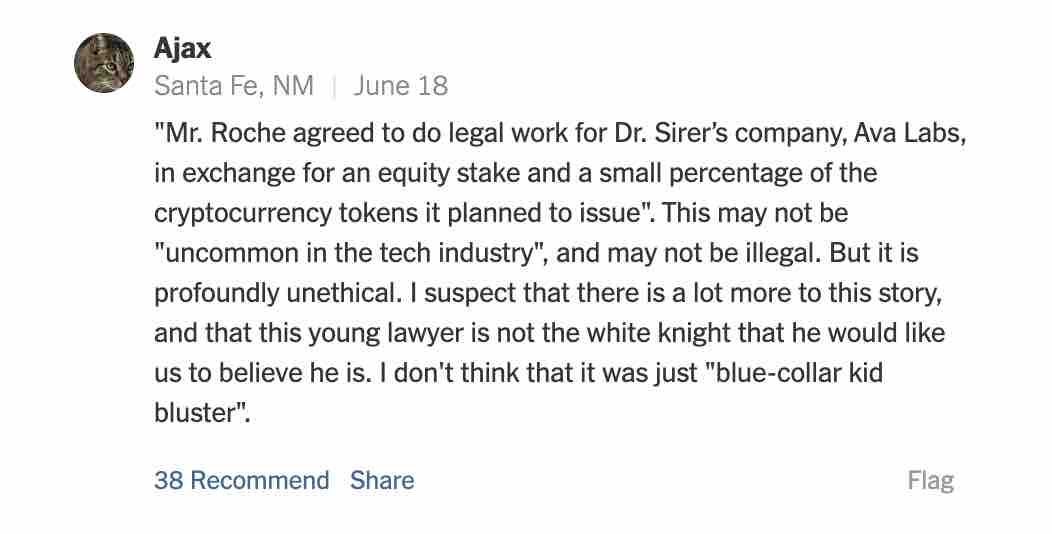Key findings
- The New York Times has a established a track record of writing puff pieces for crypto villains.
- Their new puff piece closely aligns with their hidden financial interests, and is not impartial journalism.
- The article promotes baseless, unsubstantiated and transparently self-serving claims by self-declared liar, and disgraced crypto lawyer, Kyle Roche, who is currently being kicked off his cases by American judges (see historical Case #3 for the reasons).
- We believe the purpose of the article is likely to gain advantage in a lawsuit resulting from their co-publishing of paid defamation in 2021 (see historical Case #2) by undermining the reputation of the plaintiffs suing them.
- We share the full context of the article, including disturbing links to arch crypto villain Sam Bankman-Fried. We then provide a point-by-point breakdown and analysis of the article — revealing its wilful bias and the incorporation of plain lies.
- Many readers of The Times have already been perplexed by the biased nature of the content, which platforms Kyle Roche's defamatory claims without providing supporting evidence.
June 18th, The New York Times published a story titled “He Went After Crypto Companies. Then Someone Came After Him.” (See here.)
There are major problems with the story, which we explain in this response. We would welcome The Times joining the efforts of Crypto Leaks's investigative journalism operation to expose wrongdoing in the crypto industry. In their reporting of Kyle Roche, they missed the perfect opportunity to do so.
The Background
The story is written by well-known journalist John Carreyrou in his first piece for The Times. However, his article resembles an attempt to rehabilitate Kyle Roche, a self-confessed lying lawyer and notorious crypto villain, who was exposed by our Case #3 spy video, while providing him with a platform to smear his enemies.
This is not the first “puff piece” The Times has written for a crypto villain, through which we argue they have transitioned from a simple writer of crypto stories, to being part of the crypto story.
But what happened, and what is happening?
The Times established a track record with crypto puff pieces as an avid cheerleader for shock crypto villain and faux philanthropist, Sam Bankman-Fried. Sam stole billions of dollars from customers of his crypto exchange, FTX, which he invested in grand empire-building efforts, eventually causing his customers devastating losses and triggering a worldwide backlash against the entire blockchain industry. The Times continued to write puff pieces for Sam, even as the elaborate facade he built crumbled around him.
Andrew Ross Sorkin, The Times's star reporter and media pundit, kept Sam close as a prized contact. He even invited Sam to speak at their DealRoom Summit, which provided Sam with a platform, where he could promote himself alongside luminary world leaders such as Volodymyr Zelensky, the President of Ukraine, and Janet Yellen, the US Treasury Secretary.
To acquire widespread influence, Sam lavished millions of dollars on political causes aligned with The Times, ultimately distributing funds to an incredible one third of the members of US Congress. Sam also dropped millions on certain media outlets in the form of donations, including Semafor, Vox, The Intercept, ProPublica and The Law and Justice Journalism Project, as well as quietly providing lavish sums of money to executives running crypto publications, in efforts to inoculate himself against critical investigation.
Mysteriously, the Times was listed as a creditor of FTX in its bankruptcy proceedings, showing that they too were somehow receiving monies from Sam.
We believe that The Times's latest article reflects hidden motives, and far from being impartial journalism, reflects them leveraging their platform in self-interest — in relation to a lawsuit.
The “Someone [who] Came After Him [Kyle Roche]” in the title is none other than us, Crypto Leaks. We aim to expose big money corruption and hidden attacks in the crypto industry using undercover reporting that involves the collection of spy videos, and the revelation of otherwise hidden facts and data i.e. by sharing hard evidence with our readers. Our evidence has proven true time and time again.
What is the subject matter of The Times's story?
The Times's story revolves around crypto lawyer Kyle Roche and our Case #3, published August 2022. That case shared video of Kyle, in which he detailed how his law firm weaponized the American legal system on behalf of a secret paymaster called Ava Labs, which is the developer and promoter of the Avalanche blockchain.
By obtaining a lawsuit and other information, we exposed that six key partners at his firm, Roche Freedman (now renamed “FNF”), were granted huge numbers of AVAX tokens by Ava Labs worth hundreds of millions of dollars at the time — which was done to secretly align their financial incentives with those of Ava Labs, such that any advantage they could provide the Avalanche blockchain through the legal system would increase the value of both their AVAX holdings.
On our video, Kyle explained that his firm sued entities in the crypto industry to create “magnets” for American regulators like the SEC and CFTC, which acted as decoys to draw them away from Ava Labs, that they harvested confidential industry information for Ava Labs using legal discovery processes, and that they launched American securities class actions against other blockchain projects because of Avalanche.
They had already created a securities class action against DFINITY, shortly after the Internet Computer network (see internetcomputer.org) they developed had launched. On the video, Kyle predicted how they would create an additional securities class action, surreptitiously on behalf of Ava Labs, against a blockchain called Solana (see solana.com), which they duly did a few months later.
After the publication of Case #3, Kyle's legal career began to unravel. His firm began to be kicked off the cases they created by American federal judges, which process continued even after Kyle ceremoniously left his law firm in an attempt to clean the slate. Recently, they were also kicked off the class action they created against DFINITY.
The publication of Case #3 upset Kyle and the partners at his law firm, as well as crypto billionaire Emin Gün Sirer, the CEO and driving force behind Ava Labs. We later published two further cases about Ava Labs, Case #5 and Case #6.
Kyle now makes baseless claims about Case #3, including that his statements were lies that he was psychologically manipulated into inventing by a man touching his forehead in one of his meetings with us. Other baseless claims paint an even more dramatic story, which we cover below. Kyle further says video we collected incorporates deepfake modifications made using artificial intelligence. These baseless claims strain credulity and are self-serving. In The Times's article, he also assigns responsibility for Crypto Leaks to DFINITY, also targeting them with his baseless claims — without providing supporting evidence.
But why would The Times platform claims that look like defamatory smears without supporting evidence?
The Times is currently facing a defamation lawsuit from DFINITY in Manhattan, which they have applied to have dismissed. We believe the real purpose of the The Times's puff piece is to elevate Kyle's smears stories — to undermine DFINITY, and help persuade the judge their publication of defamatory claims did not amount to actual malice, the standard required to sue journalists for defamation — to increase the chances that the lawsuit is dismissed.
But why would DFINITY be using The Times for defamation in Manhattan in the first place?
In our Case #2, we exposed how The Times published professionally-created defamation targeting DFINITY in June 2021, shortly after the Internet Computer network they developed had transitioned into production mode. The defamatory material was created by a then unknown crypto outfit called Arkham Intelligence, which we exposed using spy video and other means. We showed how they were run by fringe cryptocurrency actors, who had no credentials related to producing research, with a founder and CEO in his early twenties, Miguel Morel, who had links to a cult, and a close associate who is an anti-Semite that celebrates Adolf Hitler's birthday.
The video we collected revealed that Arkham was somehow paid to produce the report. As a consequence of Case #2, DFINITY then filed a defamation lawsuit against both Arkham Intelligence and The Times.
In a demonstration of how nefarious actors in crypto and blockchain often combine to defeat competitive threats — in Byzantine ways driven by financial self-interest — we now believe by Arkham's professional defamation was possibly commissioned by Sam Bankman-Fried himself, whom The Times was championing at the time, and who was a key contact of Andrew Ross Sorkin, their star reporter and media pundit.
But what motive would Sam have to commission the Arkham report?
At the time, Sam had become so influential in Silicon Valley, it was nearly impossible for Web3 startups to raise funding unless his participation was first secured, for example by receiving investment from Alameda Research, or FTX Ventures. He had become a Pied Piper for venture capital that invested alongside him, and he was too big to fail, but he had no connection to the Internet Computer project.
Meanwhile, Sam had been stealing billions of dollars of assets from customers of his FTX crypto exchange, and funneling the proceeds into an epic empire-building and influence-peddling effort that had entranced Silicon Valley.
Sam secretly also owned a large segment of the aforementioned crypto network called Solana. Sam depended on the value of his Solana assets filling the hole he was creating in the assets of FTX customers. When the Internet Computer network transitioned into production mode May 2021, its technology threatened the value of those assets. It was well-known in the industry, that in 2018 DFINITY had successfully accelerated a program developing the technology behind the Internet Computer. Their R&D program had been running since 2016 at a scale far exceeding others in blockchain, and it employed many of the world's top computer science researchers, cryptographers, and engineers.
DFINITY had publicly announced that the technology under development had been built and was working and would soon be deployed upon launch. They claimed the network could act as a Web3 alternative to traditional IT, such as cloud services, and enable more powerful forms of Web3, which would directly undermine Solana.
Case #1 shows how a futures instrument was mysteriously created on his FTX exchange just four days before this launch, and was used to drive the initial spot market price of its ICP token 5X higher over four hours before trading went live, causing it to launch with a fully-diluted market capitalization of $230 billion. This predicatably caused the price of ICP to crash thereafter, harming the reputation of DFINITY and the Internet Computer network, unleashing massive shorting activities, and allowing the troll farms of competitors to claim the project was a pump-and-dump scheme or “rug pull.” Case #1 was our initial coverage of those events, and our more recent Case #4 covers why the illegal manipulation of token prices on markets was a routine practice for Sam.

Arkham's defamatory report, and its mysterious publication by The Times, played a key role in the overall attack designed to turn people away from the Internet Computer network at its inception.
How and why would Sam have involved The Times?
Arkham's report would normally have had little effect, because of its highly dubious origins and content. However, its publication in close cooperation with The Times, thanks to their star reporter Andrew Ross Sorkin, turned it into a weapon of mass destruction, which wreaked havoc on the reputation of the project, and the market for its token.
The defamatory claims of the report were widely disseminated and reused — including by Roche Freedman themselves, which heavily based their securities class action against DFINITY on its content, as well as the supporting statements of The Times. Meanwhile, the tokens of Solana, and other blockchains filled the gap, and hugely spiked, allowing their backers to raise billions.
Weeks before crypto twitter exposed the FTX fraud, Andrew Ross Sorkin was on CNBC calling SBF the “JP Morgan of crypto.” No shame pic.twitter.com/rrPh4twkWt
— Nick Tomaino (@NTmoney) November 25, 2022
In the Fall of 2022, The Times was still championing Sam, months after our Case #1 had courageously first raised concerns about serious wrongdoing in June 2022. Despite the evidence, Andrew Ross Sorkin was now promoting him as the "J.P. Morgan of Crypto."
When The Times published the Arkham report a year earlier, June 2021, Sam was already a prolific donor to American politicians, and had publicly promised to donate $1 billion dollars in campaign contributions to keep Donald Trump from power, in addition to the vast sums he was already spending on influence peddling behind the scenes.
In the absence of a directive from a powerful figure with inside access to The Times, there is no way that The Times would publish material from Arkham or content of that nature.
Owing to the accumulating evidence that Crypto Leaks has discovered and presented, our previous cases have demanded that Sam Bankman Fried, Andrew Ross Sorkin, or their lawyers, deny suspicions of their collusion, but no denials have been forthcoming.
Now many people, including The Times's own loyal readers, have been perplexed about why they have written another transparent puff piece for a crypto villain. That this possibly relates to earlier crypto villainy will surprise many. The backstory is complex, but we will continue our efforts to raise awareness, and will soon reveal additonal evidence.
Anatomy of a crypto villain puff piece
The following point-by-point analysis of The Times's article shows how they wilfully mischaracterize Kyle, promote and legitimize his baseless defamatory claims — even though he is a self-confessed liar that federal judges are kicking off cases — and introduce subtle lies of their own that mislead the reader.
The photos tell a story
Kyle Roche, a self-confessed liar and disgraced lawyer with murky motives whom judges have been kicking off cases, is given star treatment from a professional photographer from The Times. The first photo in the article presents a heroic profile, with a faux noble gaze. The real Kyle Roche can be see on video in Case #3.

NYT: “He boasted a law firm bearing his name, lawsuits filed against more than a dozen crypto companies and a huge verdict against the man who claimed to have invented Bitcoin.”
The Times introduces Kyle as being a “a rising star in the field of cryptocurrency law.” They say he achieved a “huge verdict" against Craig Wright, a Bitcoin player his firm sued on behalf of of a deceased business partner's half-brother.
This recounting is an egregious mischaracterization of events: the referenced lawsuit failed to secure any actual funds from Wright, or prove its claims, and in the process of prosecuting the lawsuit, they landed their client with debilitating legal costs.
The judge in the case said:
| “ | “I find that it is a prevailing party and entitled to recover its taxable costs. And, given that Mr. Kleiman did not succeed on any of his claims and W&K did not succeed on five of its claims, I find that Dr. Wright is the prevailing party as to those claims and thus, he is entitled to an award of costs as well.” |
You can read the full court docket at courtlistener.com.
NYT: “When he woke up the next morning, Mr. Roche says, he felt groggy … The brain fog was odd because he didn't think he'd had all that much to drink”
At our second meeting with Kyle, over dinner, we recored statements about his involvement with corrupt schemes, and which reflected a contempt for the American legal system. He now baselessly claims — without evidence — we slipped something into his wine, causing him to lie and act out of character.
The Times only tiptoes towards his claim here, saying Kyle felt groggy the next morning, and had an odd brain fog. They share the full baseless tale later, after further attempts to establish his credibility...
NYT: “Mr. Roche was felled by his own loose lips and his overly cozy relationship with a client. But he also was the victim of an elaborate international setup.”
Kyle was indeed “felled by his own loose lips,” but The Times misleadingly tags on “and his overly cozy relationship with a client.” Being close to a client (Ava Labs) does not mitigate corruption.
The Times then further curries sympathy for Kyle by adding he was the “victim of an elaborate international setup.” But describing our investigation into his corrupt practices as a “setup” that victimized him is another mischaracterization.
When a person involved in corruption is exposed, they are the victim of themselves, not the investigators.
Why isn't The Times lauding Crypto Leaks for running investigations that expose hidden corruption in the crypto industry using hard evidence?
NYT: “The New Sheriff”
The Times now gives Kyle the title of "New Sheriff," but the evidence suggests he is really the epitome of everything that went wrong with the crypto industry, and the antithesis of a sheriff.
The comments section of The Times's article reveals some loyal readers feel the same dissonance as us:







NYT: “Mr. Roche grew up in a working-class family in Buffalo. The oldest of four siblings, he shared a bedroom with intellectually disabled twin brothers … he could one day provide for them.”
The Times next shares an endearing backstory about Kyle's working-class background with disabled brothers, and his determination to provide for them.
However, this doesn't justify his professional misdeeds and conduct in the crypto industry. (Members of the mafia also provide for their families.)
NYT: “It reminded him of pump-and-dump scams in which a group inflates the price of a stock by talking it up publicly before selling all at once and making off with the profits … Regulators didn't seem to be doing anything about it, so Mr. Roche decided he would.”
The Times now mischaracterizes their "New Sheriff" as a crypto crusader who chases down crypto pump-and-dump scams.
In fact, aside from tying up competitors of Ava Labs up with lawsuits, Kyle's firm (Roche Freedman) primarily sought targets from whom they could extract settlements, for example by creating a class action against Ledger, the reputable hardware wallet manufacturer, after their customer list was hacked.
NYT: “It alleged that a British entrepreneur, Dominic Williams, and entities he controlled had swindled investors out of billions of dollars by aggressively promoting, and then dumping, a digital coin tied to a grandiose plan to revolutionize computing.”
The Times now revamps claims that are 2 years old, for which no supporting evidence has emerged — even though copius evidence has entered the public domain indicating they have malicious origins and are baseless.
The author additionally describes the Internet Computer project as a "grandiose plan to revolutionize computing," subtly lending credence to the baseless claims by implying that DFINITY or its founder may have made exaggerated sales pitches to lure people into a pump-and-dump scheme.
However, the Internet Computer's technology was developed over many years by a team of hundreds of research scientists, cryptographers and engineers at DFINITY, many very senior, well-regarded, and even famous within their respective fields. There is absolutely no evidence that the technology does not perform as claimed, and no credible person is claiming this is the case. The Times is in the gutter here, but why?
We cannot know what goes on at The Times — but any time now a Manhattan judge may decide on their application to have the defamation lawsuit DFINITY filed against them dismissed.
In America, only journalists that act with "actual malice" can be prosecuted for defamation (simple negligence isn't enough) but publishing Arkahm's paid defamation material without checks to please a coveted contact would qualify.
Could The Times be trying to suggest to the judge that the claims were sufficiently credible that checks weren't required?
NYT: “Mr. Williams had boldly proclaimed that his Internet Computer blockchain — a decentralized network of computers powered by a digital token called ICP — would supplant the big cloud services offered by Amazon and Microsoft and become humanity's primary computing platform.”
Our research shows that the founder has only stated that the mission (i.e. ambition) of the Internet Computer network is to host a majority of the world's systems and services, with the aim of delivering well-defined benefits to humanity.
Could this straightforward lie be designed to further persuade readers that DFINITY or its founder lured people into a pump-and-dump scheme?
NYT: “A Big Verdict”
The Times again mischaracterizes Kyle's failed lawsuit against Craig Wright, but this time they spin a more elaborate story.
NYT: “The Setup”
The Times now introduces our successful investigation into Kyle and the corruption he described as a “setup”...
NYT: “According to Mr. Roche, Mr. Ager-Hanssen pressed his index finger to Mr. Roche's forehead … he took it as a cue to sell himself harder.”
When Crypto Leaks first met Kyle at the office of Christian Ager-Hanssen, Kyle was pitching Christian to invest into his litigation financing startup, Ryval. (Given Kyle's interest in securities class actions, it's ironic Ryval would have tokenized litigation, and raised funds for suing crypto projects by selling its tokens to the public.)
During the meeting we filmed Kyle making numerous statements about his corrupt actions, which he now claims are lies he invented.
His story is that Christian psychologically manipulated him into inventing the lies, including by touching his forehead: “I didn't think it was a gun motion, but I thought he was trying to intimidate me.”
The Times earlier describes Kyle as a “rising star in the field of cryptocurrency law,” which is surely inconsistent with the idea he could be manipulated this way. Christian Ager-Hanssen is also human, not Dr. Spock from Star Trek.
Why on earth would The Times platform this?
NYT: “Mr. Roche recalls Mr. Ager-Hanssen arriving about 15 minutes later and sitting at a nearby table with a tall blond man.”
At our second meeting with Kyle, over dinner, Christian Ager-Hanssen was not present, or anywhere near.
NYT: “Mr. Roche says the rest of the evening was a blur. He now believes the drink was laced with a drug, though he has no proof.”
When we met Kyle at a London club for dinner, our investigative journalist filmed Kyle making additional statements on video, and sharing information that is corroborated by independent evidence.
Kyle made a spectacular prediction about how his firm would later create a class action against Solana, secretly on behalf of Ava Labs, which they duly filed months later. He also mocked the American legal system, calling juries “10 idiots,” and said described how he could easily bamboozle American judges about blockchain matters.
To explain these additional statements, Kyle now spins a baseless story. Crypto Leaks did not put anything in Kyle's drink, carefully observes the law, and is ethical. Moreover, there was no need: Kyle readily volunteered the words that sunk him hours before at our earlier meeting in Christian's offices, and did so again at the dinner.
Kyle additionally baselessly claims our videos from dinner have deepfake alterations created using artificial intelligence.
NYT: “A week after the videos surfaced, Mr. Roche got another jolt: A friend of one of his colleagues reported that he had heard rumors at a crypto event that Mr. Roche's life was in danger, according to an affidavit later filed in court. Spooked, Mr. Roche and his fiancée hunkered down in a short-term rental in Brooklyn.”
After our Case #3 was published, Kyle now claims that he heard serendipitously, fourth-hand, that the DFINITY foundation wished him physical harm, and that his life was in danger.
Kyle's story is that a junior colleague at his law firm, had a friend, who went to a cryptocurrency conference, and claimed he overheard unidentified people discussing an alleged threat, which was then reported back.
The story includes unidentified persons to the chain of events, which ensures that it cannot be disproven. But without evidence, there is no reason to believe, let alone legitimize, such a story.
Perhaps to add credence to his conspiracy story, Kyle seems to have acted out a pantomime, which involved “hunkering down” with his fiancé in a rental apartment in Brooklyn. While The Times doesn't dare state Kyle's story is true, they willfully dramatize and legitimize his tale by retelling it in the mode of a thriller, and by having their photographer collect a heroic picture of him standing before Brooklyn bridge with golden sunlight streaming behind:

It is completely wrong and irresponsible of The Times to platform this self-serving conspiracy story, which is transparently defamatory:
1. DFINITY is a large reputable research and development organization.
2. If the friend of Kyle's colleague really overheard alarming plans at the cryptocurrency conference, why didn't he record names or take photos?
3. If Kyle was really worried about his security situation, why did he recently publish a tweet publicly identifying his wife?
A reader of The Times comments:

NYT: “A Series of Clues”
The Times then insinuates that DFINITY and its founder Dominic Williams might be involved with Crypto Leaks, in the manner of a whodunnit.
As the American federal courts have noted, the focus on trying to determine who is behind Crypto Leaks is entirely misplaced as a basis for trying to absolve Kyle of his serious professional misconduct. Why then would The Times even pursue this inquiry, let alone point a finger at DFINITY?
Could this confirm the real intent of the article is to discredit DFINITY by platforming the false claims of a crypto villain, to boost their fight against a defamation lawsuit that DFINITY has filed against them?
Taking on an establishment Goliath in Manhattan
As an organization, we are of course aware what we have taken on.
The New York Times is an American media powerhouse, with tremendous reach, and the support of establishment politicians and regulators who are aligned with its general perspectives, who in turn rely on its support.
A great disaster befell this powerhouse, and many of their supporters, in the shape of their support for Sam Bankman-Fried, and other crypto villains, which lies at the root of the defamation lawsuit The Times is facing — as well as the furious backlash against crypto we are now seeing in America.
Crypto Leaks invites The Times to stop glorifying a crypto villain like Kyle Roche as a strategy to try and defend itself from a pending defamation lawsuit resulting from their inexplicable and malicious publishing of the defamatory Arkham report.
Crypto Leaks will continue publishing new cases. Some will be directly relevant to the role The Times has played in the crypto industry.
Read more case investigations...
We show the public what goes on behind the scenes in crypto. If you can help, please become a whistleblower.